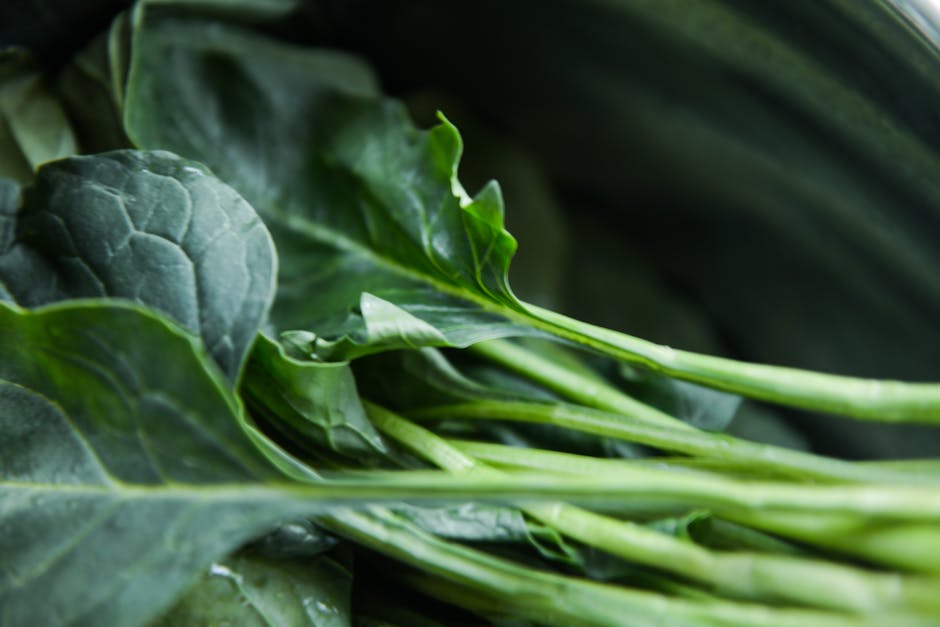is collard greens high in oxalates-2024
DATE : 8 January 2024 By : Tareq Qteshat

Table of Contents
Togglecollard greens high in oxalates
Oxalates are natural compounds found in many plant-based foods. They can combine with calcium to form crystals, which can be excreted through urine. While some oxalates are necessary for the body, high levels can lead to health concerns.
Excessive oxalate intake may increase the risk of developing kidney stones, especially if you have a history of stone formation. These stones can cause intense pain and discomfort, requiring medical intervention to remove them.
In addition to kidney stones, high oxalate levels may also contribute to other health issues such as gut irritation and nutrient deficiencies. Oxalates bind with minerals like calcium and iron, making them less available for absorption by the body.
To manage oxalate intake, it is important to identify food sources that are high in oxalates and choose alternatives when necessary. Collard greens, like other leafy greens, contain moderate levels of oxalates. Balancing your diet with a variety of foods can help minimize the risk of excessive oxalate intake while still enjoying the benefits of collard greens’ nutritional value.
Effects of high oxalate levels in the body

High oxalate levels in the body can have several negative effects on our health. One of the most common complications is the formation of kidney stones. These stones can range from small, grain-like crystals to larger, painful obstructions that require medical intervention for removal.
In addition to kidney stones, high oxalate intake may also contribute to gut irritation and nutrient deficiencies. Oxalates bind with minerals like calcium and iron, making them less available for absorption by the body. This can lead to a decreased intake of key nutrients, potentially impacting overall health.
It’s important to note that not everyone will experience these effects at the same level. Some individuals may be more prone to developing kidney stones or experiencing gastrointestinal issues due to their unique physiology or medical conditions.
To manage oxalate intake and minimize potential health risks, it’s advisable to consume a balanced diet that includes a variety of foods. This way, you can still enjoy the nutritional benefits of collard greens while maintaining a healthy oxalate level in your body.
Factors that may contribute to high oxalate intake

Factors that may contribute to high oxalate intake can vary from person to person. Some individuals naturally produce higher levels of oxalates in their body, while others may consume foods that are rich in oxalates. Medical conditions such as hyperoxaluria or gastrointestinal disorders can also lead to increased absorption of oxalates from the diet.
Certain dietary choices can also contribute to higher oxalate intake. Diets that are high in processed foods, sugars, and animal products may increase the risk of consuming excessive amounts of oxalates. Additionally, consuming large quantities of foods known to be high in oxalates, such as spinach, beet greens, and rhubarb, can also contribute to higher intake levels.
It’s important to note that individual tolerance to oxalates varies. While some individuals may have a higher threshold for tolerating oxalates without experiencing negative health effects, others may be more sensitive and prone to developing complications like kidney stones.
To manage oxalate intake, it’s recommended to maintain a balanced diet and consult with a healthcare professional or registered dietitian who can provide personalized guidance based on your unique needs and medical history.
Understanding Collard Greens

Collard greens are leafy green vegetables that belong to the Brassica family, which also includes Brussels sprouts and kale. They have been a staple in Southern cuisine for centuries and are gaining popularity worldwide due to their unique flavor and nutritional benefits.
These vibrant green leaves are packed with essential vitamins and minerals, making them a nutritious addition to any diet. Collard greens are an excellent source of vitamins A, C, and K, as well as folate and calcium. They also contain fiber, iron, and antioxidants that contribute to overall good health.
In terms of taste, collard greens have a slightly bitter and earthy flavor that pairs well with various ingredients. They can be enjoyed raw in salads or steamed, sautéed, or braised for a softer texture. Commonly used in dishes like soups, stews, or side dishes, collard greens offer versatility both in terms of preparation methods and culinary applications.
By incorporating collard greens into your meals, you can enjoy their unique taste while reaping the numerous health benefits they provide.
Nutritional value of collard greens

Collard greens are not only delicious but also packed with essential nutrients that can benefit our overall health. These vibrant leafy greens are a great source of vitamins A, C, and K. Vitamin A helps support healthy vision and boosts the immune system, while vitamin C is important for collagen production and acts as an antioxidant to protect our cells from damage. Vitamin K plays a crucial role in blood clotting and bone health.
In addition to vitamins, collard greens are rich in minerals such as calcium, folate, and iron. Calcium is essential for strong bones and teeth, while folate supports cell growth and development. Iron helps transport oxygen throughout the body and prevents anemia.
Furthermore, collard greens provide dietary fiber, which aids digestion and promotes a healthy gut. They also contain antioxidants that help fight inflammation and protect against chronic diseases.
By incorporating collard greens into our meals, we can enjoy their delicious taste while nourishing our bodies with these beneficial nutrients.
Common uses and recipes for collard greens

When it comes to collard greens, there are plenty of delicious ways to incorporate them into your meals. One common use for collard greens is in salads, where you can chop and toss them with your favorite veggies and dressing for a refreshing and nutritious dish.
Collard greens are also commonly used in soups and stews. Their hearty texture holds up well, adding a unique flavor to the dish. You can sauté them with onions and garlic as a side dish or add them to your stir-fries for an extra boost of nutrients.
Another popular way to enjoy collard greens is by blanching or steaming them and using the leaves as wraps for fillings like quinoa, beans, or tofu. These make for a tasty and healthy alternative to tortillas or bread.
If you’re looking for a traditional Southern-style preparation, try boiling collard greens with smoked ham hocks or bacon for a flavorful side dish.
Get creative with your recipes and discover all the tasty ways you can enjoy collard greens as part of a balanced diet!
Oxalate Content in Collard Greens

Collard greens have a moderate oxalate content, which is important to consider if you are following a low oxalate diet or have conditions such as kidney stones. While collard greens are packed with beneficial nutrients, their oxalate levels may vary based on the cooking method.
According to research, raw collard greens contain approximately 50-60 milligrams of oxalates per 100 grams. However, the oxalate content can be reduced by cooking the greens. Boiling collard greens in water and draining off the liquid can decrease the oxalate levels by up to 30%.
It’s worth noting that steaming or microwaving collard greens can help retain more nutrients compared to boiling. So, if you’re concerned about oxalates but still want to enjoy this nutritious vegetable, opt for alternatives like steaming or sautéing.
Remember, moderation is key when it comes to managing oxalate intake. Keep an eye on portion sizes and balance your overall diet with other low-oxalate foods for optimal health.
Oxalate levels in raw collard greens

When it comes to oxalate levels in raw collard greens, they contain approximately 50-60 milligrams of oxalates per 100 grams. However, it’s important to note that these levels can vary slightly depending on factors such as the specific variety of collard greens and agricultural practices.
I personally love incorporating raw collard greens into my salads or using them as a wrap for healthy fillings. But if you’re concerned about oxalates due to health reasons, you may want to consider cooking your collard greens.
Boiling collard greens in water and then draining off the liquid can help reduce their oxalate content by up to 30%. This is a simple way to enjoy this nutrient-packed vegetable while minimizing your overall oxalate intake.
Remember, moderation is key when it comes to managing oxalates. By being aware of the oxalate levels and considering different cooking methods, you can still enjoy the benefits of collard greens while keeping your overall health in mind.
Impact of cooking methods on oxalate content
When it comes to managing oxalate levels in collard greens, cooking methods can play a significant role. While raw collard greens contain approximately 50-60 milligrams of oxalates per 100 grams, certain cooking techniques can help reduce this content.
One effective method is boiling the collard greens in water and then draining off the liquid. This simple process can reduce the oxalate content by up to 30%. By boiling the greens, some of the oxalates are leached out into the water, resulting in a lower overall oxalate intake when consumed.
Alternatively, you can also opt for steaming or sautéing collard greens with minimal water. These cooking methods have been found to retain more of the natural nutrients while also reducing oxalate levels compared to boiling.
Remember, moderation is key when it comes to managing oxalates. By being mindful of different cooking methods and incorporating a variety of vegetables into your diet, you can enjoy the health benefits of collard greens while minimizing your overall oxalate intake.
Health Implications of High Oxalate Intake
When it comes to high oxalate intake, the most well-known health implication is the formation of kidney stones. Excessive levels of oxalates can combine with calcium in the kidneys, forming hard deposits that can cause intense pain when passing through the urinary tract.
However, there are other potential health risks associated with high oxalate intake as well. Consuming large amounts of oxalates can interfere with the absorption of certain minerals like calcium and iron, leading to deficiencies over time. This can have a negative impact on bone health and overall nutrient balance in the body.
It’s important to note that not everyone is equally susceptible to the effects of high oxalate intake. Some individuals may be more prone to kidney stone formation or have pre-existing conditions that make managing oxalates even more crucial.
To minimize these health risks, it’s essential to be mindful of your oxalate consumption and maintain a balanced diet that includes a variety of fruits, vegetables, and other nutrient-dense foods.
Link between oxalates and kidney stones
One of the most well-established links when it comes to oxalates is their connection to kidney stones. Your kidneys play a crucial role in filtering waste products from your blood, and oxalates can bind with calcium to form hard crystals that can accumulate in the kidneys.
When these oxalate crystals combine with calcium, they can create kidney stones. These stones can vary in size and may cause severe pain as they pass through the urinary tract. Individuals who have a higher intake of oxalates may be more prone to developing kidney stones.
It’s important to note that not everyone who consumes oxalates will develop kidney stones, and factors like hydration levels, genetics, and overall health also play a role. However, for individuals who are predisposed to kidney stone formation or have a history of kidney issues, managing oxalate intake becomes even more important.
By being mindful of your oxalate consumption and maintaining proper hydration, you can help reduce the risk of developing kidney stones and promote overall urinary tract health.
Other potential health risks associated with high oxalate intake
Other potential health risks associated with high oxalate intake include not only kidney stone formation but also the possibility of developing conditions such as hyperoxaluria and calcium oxalate deposition in various organs. Hyperoxaluria is a condition characterized by excessive oxalate production or difficulty in metabolizing oxalate. This can lead to the formation of kidney stones, as well as deposits of calcium oxalate in other organs such as the heart, brain, and bones.
Furthermore, high levels of oxalates in the body have been linked to increased risk of inflammation and oxidative stress, which can contribute to the development or worsening of conditions such as arthritis, cardiovascular disease, and even certain types of cancer.
While it’s important to be aware of the potential health risks associated with high oxalate intake, it’s crucial to remember that individual tolerance and susceptibility can vary greatly. Maintaining a balanced diet rich in a variety of nutrients is key, along with staying properly hydrated and managing any existing health conditions. Consulting with a healthcare professional can provide personalized guidance on managing your oxalate intake and overall health.
Managing Oxalate Intake
Managing Oxalate Intake is essential for maintaining a balanced diet and promoting overall health. Here are some tips to help manage your oxalate intake:
- Stay hydrated: Drinking plenty of water can dilute the concentration of oxalates in your urine, reducing the risk of kidney stone formation.
- Cook collard greens properly: Proper cooking methods such as boiling or steaming can reduce the oxalate content in collard greens. Avoid high-temperature cooking techniques like frying, which may increase their oxalate levels.
- Pair collard greens with calcium-rich foods: Consuming calcium-rich foods like dairy products or fortified plant-based alternatives alongside collard greens can help bind with dietary oxalates and prevent them from being absorbed by your body.
- Practice portion control: While collard greens are nutritious, consuming excessive amounts can lead to higher oxalate intake. Enjoy them as part of a varied diet without overindulging.
Remember, everyone’s tolerance and susceptibility to oxalates differ. If you have specific concerns about high oxalate intake, it’s best to consult with a healthcare professional who can provide personalized guidance for managing your dietary choices and overall well-being.
Tips for reducing oxalate intake

When it comes to reducing oxalate intake, I’ve found a few strategies that have worked for me. First and foremost, staying hydrated is key. Drinking plenty of water helps dilute the concentration of oxalates in urine, decreasing the risk of kidney stone formation.
Another helpful tip is to cook collard greens properly. Boiling or steaming them can actually reduce their oxalate content. Avoid high-temperature cooking methods like frying, as they may increase oxalate levels.
Pairing collard greens with calcium-rich foods has also been effective for me. Consuming dairy products or fortified plant-based alternatives alongside collard greens helps bind with dietary oxalates, preventing them from being absorbed by my body.
Lastly, practicing portion control is important. While collard greens are nutritious, consuming excessive amounts can lead to higher oxalate intake. So, enjoy them as part of a varied diet without overindulging.
Remember, everyone’s tolerance and susceptibility to oxalates differ. For personalized guidance on managing your dietary choices and overall well-being, it’s best to consult with a healthcare professional.
Other dietary considerations for individuals with high oxalate levels
When managing high oxalate levels, it’s important to consider other aspects of your diet. Incorporating foods that are low in oxalates can help balance your overall intake. Some examples include incorporating more fruits like bananas, oranges, and strawberries into your meals. These fruits are not only low in oxalates but also provide essential vitamins and minerals.
In addition, including calcium-rich foods such as dairy products, fortified plant-based alternatives, and nuts can be beneficial. Calcium helps bind with oxalates during digestion, preventing their absorption by the body.
Furthermore, it’s essential to maintain a well-balanced diet that includes a variety of nutritious foods. This ensures you’re getting a wide range of nutrients while managing your oxalate intake.
Remember to consult with a healthcare professional or registered dietitian for personalized advice on managing high oxalate levels and optimizing your overall health. They can provide specific dietary recommendations tailored to your individual needs.
Conclusion
In conclusion, collard greens are a nutritious vegetable that can be a valuable addition to a balanced diet. While they do contain oxalates, the overall health benefits and nutritional value outweigh any potential risks for most individuals. Collard greens are packed with vitamins, minerals, and fiber that support overall well-being and can help prevent chronic diseases.
To manage oxalate intake, it’s important to cook collard greens using methods that reduce oxalate content, such as boiling or steaming. It’s also beneficial to balance your diet by incorporating foods low in oxalates and high in calcium, like fruits and dairy products.
Remember to consult with a healthcare professional or registered dietitian for personalized advice on managing high oxalate levels and optimizing your overall health. They can provide tailored recommendations specific to your individual needs.
By making informed choices about your diet and incorporating collard greens in moderation, you can enjoy their many health benefits while maintaining a balanced intake of oxalates. So go ahead, add some collard greens to your next meal and reap the rewards of their nutritional goodness!
Benefits of including collard greens in a balanced diet
Balancing oxalate intake and overall health
Tags: benefits of collard greens, collard, collard greens, collard greens benefits, collard greens health benefits, collard greens healthy, collard greens recipe, collard greens recipes, controversy over oxalates in greens, foods high in calcium, foods high in oxalates, greens have oxalates, health benefits of collard greens, high oxalate foods, how to eat collard greens, oxalate, oxalates, oxalates in food, oxalates in spinach, oxalates in vegetables







0 thoughts on “is collard greens high in oxalates-2024”